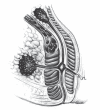Update on anal fistulae: surgical perspectives for the gastroenterologist
- PMID: 22175058
- PMCID: PMC3266159
- DOI: 10.1155/2011/931316
Update on anal fistulae: surgical perspectives for the gastroenterologist
Abstract
Anal fistulae are common and debilitating; they are characterized by severe pain and discharge. They arise following infection near the anal canal, or as a primary event from an abscess in the abdomen, fistulating into the vagina or perianal skin. The term 'cryptoglandular' is given to abscesses arising from the anal glands.For many years, the treatment of choice was to lay open the fistula; however, this risks causing incontinence with potentially devastating consequences. Alternative surgical treatments include setons, fibrin glue, collagen plugs and flaps to cover the internal fistula opening. These have achieved varying degrees of success, as will be discussed. The present review also discusses anal fistulae in light of much recently published literature. Currently, anal fistulae remain challenging and require specialist expertise; however, new treatment options are on the horizon.
Les fistules anales sont courantes et débilitantes. Elles se caractérisent par une douleur marquée et des écoulements. Elles se forment après une infection à proximité du canal anal ou comme événement primaire découlant d’un abcès dans l’abdomen, qui se fistulise dans le vagin ou la peau périanale. Le terme « cryptoglandulaire » est attribué aux abcès provenant des glandes anales.
Pendant de nombreuses années, le traitement de choix consistait à ouvrir la fistule, mais s’associait à des risques d’incontinence, dont les conséquences avaient un potentiel dévastateur. Les autres traitements chirurgicaux incluent les sétons, la colle à la fibrine, les bouchons de collagène et des lambeaux pour couvrir les ouvertures fistulaires internes. On démontrera que ces traitements obtiennent un succès variable. La présente analyse traite également des fistules anales à la lumière de publications beaucoup plus récentes. Les fistules anales demeurent un défi et exigent des compétences spécialisées, mais de nouvelles possibilités thérapeutiques s’annoncent.
Figures



Similar articles
-
Anal fistula plug and fibrin glue versus conventional treatment in repair of complex anal fistulas.Am J Surg. 2009 May;197(5):604-8. doi: 10.1016/j.amjsurg.2008.12.013. Am J Surg. 2009. PMID: 19393353
-
Fibrin glue-antibiotic mixture in the treatment of anal fistulae: experience with 69 cases.Dig Surg. 2000;17(1):77-80. doi: 10.1159/000018804. Dig Surg. 2000. PMID: 10720836
-
Sphincter-sparing techniques for fistulas-in-ano.J Visc Surg. 2015 Apr;152(2 Suppl):S31-6. doi: 10.1016/j.jviscsurg.2014.08.002. Epub 2014 Oct 3. J Visc Surg. 2015. PMID: 25280598 Review.
-
[MR imaging of ano-perineal suppurations].J Radiol. 2003 Apr;84(4 Pt 2):516-28. J Radiol. 2003. PMID: 12844075 Review. French.
-
Initial Experience with Fibrin Glue Treatment of Anal Fistulae in Children.Am Surg. 2018 Jun 1;84(6):1105-1109. Am Surg. 2018. PMID: 29981656
Cited by
-
Fistula-in-Ano Complicated by Fournier's Gangrene Our Experience in North-Eastern Region of Nigeria.Niger J Surg. 2013 Jul;19(2):56-60. doi: 10.4103/1117-6806.119237. Niger J Surg. 2013. PMID: 24497752 Free PMC article.
-
Factors Increasing the Risk of Recurrence in Fistula-in-ano.Cureus. 2019 Mar 7;11(3):e4200. doi: 10.7759/cureus.4200. Cureus. 2019. PMID: 31114719 Free PMC article. Review.
-
Diagnostic performance of intravoxel incoherent motion diffusion-weighted imaging and dynamic contrast-enhanced MRI for assessment of anal fistula activity.PLoS One. 2018 Jan 25;13(1):e0191822. doi: 10.1371/journal.pone.0191822. eCollection 2018. PLoS One. 2018. PMID: 29370278 Free PMC article.
-
Fibrin Sealant: The Only Approved Hemostat, Sealant, and Adhesive-a Laboratory and Clinical Perspective.ISRN Surg. 2014 Mar 4;2014:203943. doi: 10.1155/2014/203943. eCollection 2014. ISRN Surg. 2014. PMID: 24729902 Free PMC article. Review.
-
The risk factors for failure and recurrence of LIFT procedure for fistula in ano.Turk J Surg. 2023 Mar 3;39(1):27-33. doi: 10.47717/turkjsurg.2023.5807. eCollection 2023 Mar. Turk J Surg. 2023. PMID: 37275932 Free PMC article.
References
-
- Corson JD, Williamson RCN, editors. Surgery. London: Mosby; 2001. pp. 12–14.
-
- Tozer PJ, Burling D, Gupta A, Phillips RKS, Hart AL. Review article: Medical, surgical and radiological management of perianal Crohn’s fistulas. Aliment Pharmacol Ther. 2011;33:5–22. - PubMed
-
- Williams JG, Farrands PA, Williams AB, et al. The treatment of anal fistula: ACPGBI Position Statement. Colorectal Dis. 2007;9(Suppl 4):18–50. - PubMed
-
- van Koperen PJ, Horsthuis K, Bemelman WA, Stoker J, Slors JF. Perianal fistulas: Developments in the classification and diagnostic techniques, and a new treatment strategy. Ned Tijdschr Geneeskd. 2008;152:2774–80. - PubMed
-
- Davies M, Harris D, Lohana P, et al. The surgical management of fistula-in-ano in a specialist colorectal unit. Int J Colorectal Dis. 2008;23:833–8. - PubMed
Publication types
MeSH terms
Substances
LinkOut - more resources
Full Text Sources
Molecular Biology Databases
